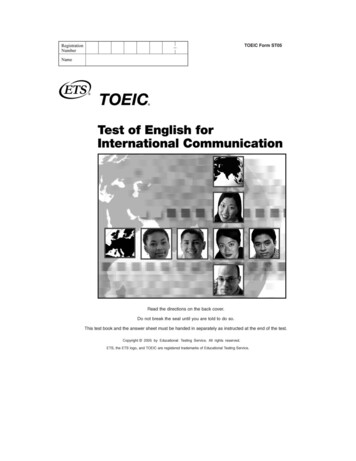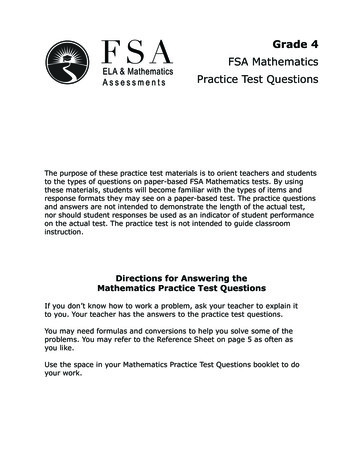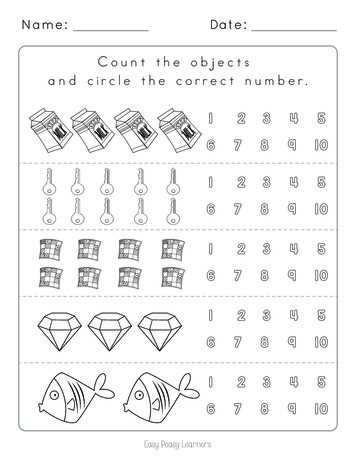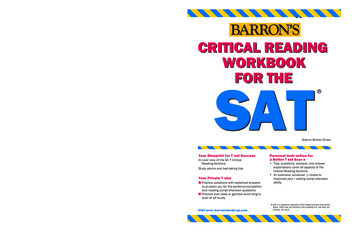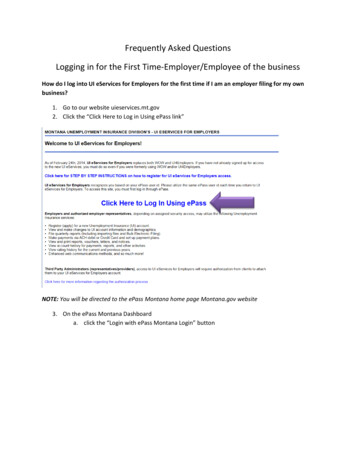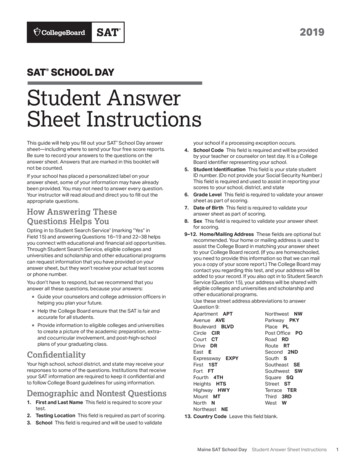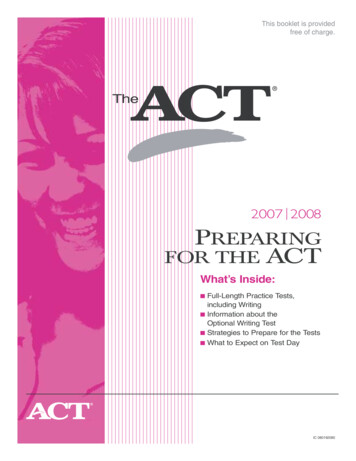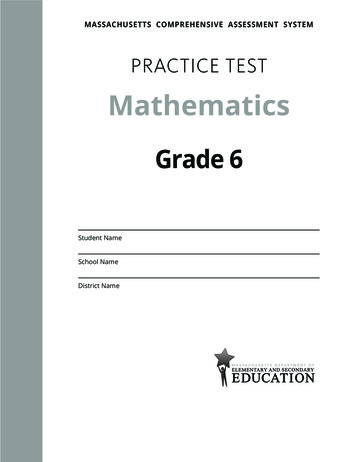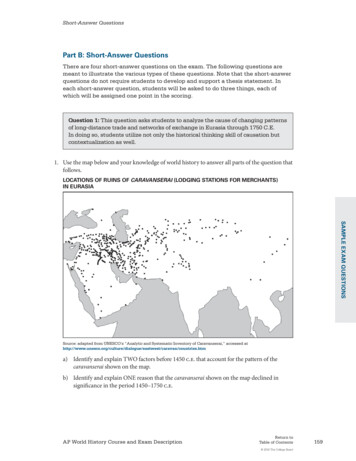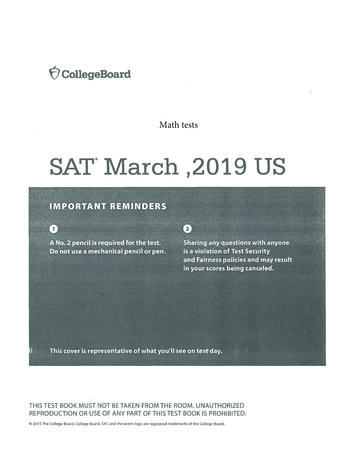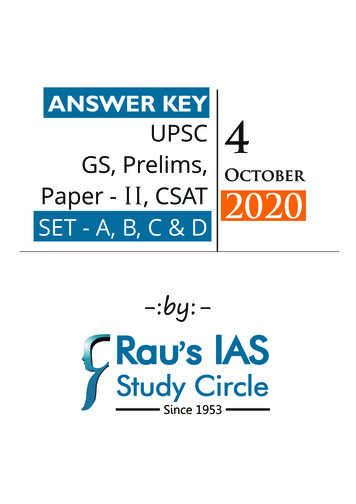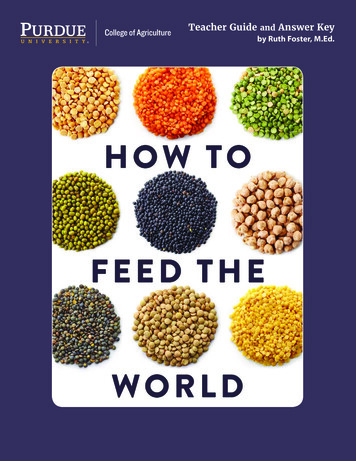
Transcription
TEACHER GUIDE and ANSWER KEYTeacher Guide and Answer Keyby Ruth Foster, M.Ed.
Table of ContentsIntroduction. 3Chapter One: Inhabitants of EarthFact Gathering and Information. 5Geography. 6Critical Thinking Practice, SAT Preparation, and Assessment. 7Investigation and Internet Research. 7Writing Focus. 8Questions for Class Discussion. 9Further Advancement/Different Teaching Modalities. 9Chapter Two: The Green, Blue, and Gray WaterRainbowFact Gathering and Information. 10Geography. 11Critical Thinking Practice, SAT Preparation, and Assessment. 12Investigation and Internet Research. 12Writing Focus . 13Questions for Class Discussion.14Further Advancement/Different Teaching Modalities.14Chapter Three: The Land that Shapes andSustains UsFact Gathering and Information.15Geography.16Critical Thinking Practice, SAT Preparation, and Assessment.17Investigation and Internet Research.17Writing Focus .18Questions for Class Discussion.19Further Advancement/Different Teaching Modalities.19Chapter Four: Our Changing ClimateFact Gathering and Information.20Geography.22Critical Thinking Practice, SAT Preparation, and Assessment.23Investigation and Internet Research.23Writing Focus .24Questions for Class Discussion.25Further Advancement/Different Teaching Modalities.25Chapter Five: The Technology TicketFact Gathering and Information.26Geography.28Critical Thinking Practice, SAT Preparation, and Assessment.29Investigation and Internet Research.29Writing Focus .30Questions for Class Discussion.31Further Advancement/Different Teaching Modalities.31Chapter Six: SystemsFact Gathering and Information.32Geography.33Critical Thinking Practice, SAT Preparation, and Assessment.34Investigation and Internet Research.34Writing Focus .35Questions for Class Discussion.36Further Advancement/Different Teaching Modalities.36Chapter Seven: Tangled TradeFact Gathering and Information.37Geography.39Critical Thinking Practice, SAT Preparation, and Assessment.40Investigation and Internet Research.40Writing Focus.41Questions for Class Discussion.42Further Advancement/Different Teaching Modalities.42Chapter Eight: Spoiled, Rotten, and Left BehindFact Gathering and Information.43Geography.45Critical Thinking Practice, SAT Preparation, and Assessment.46Investigation and Internet Research.46Writing Focus.47Questions for Class Discussion.48Further Advancement/Different Teaching Modalities.48Chapter Nine: Tipping the Scales on HealthFact Gathering and Information.49Geography.50Critical Thinking Practice, SAT Preparation, and Assessment.51Investigation and Internet Research.51Writing Focus.52Questions for Class Discussion.53Further Advancement/Different Teaching Modalities.53Chapter Ten: Social License to OperateFact Gathering and Information.54Geography.55Critical Thinking Practice, SAT Preparation, and Assessment.56Investigation and Internet Research.56Writing Focus.57Questions for Class Discussion.58Further Advancement/Different Teaching Modalities.58Chapter Eleven: The Information HingeFact Gathering and Information.59Geography.61Critical Thinking Practice, SAT Preparation, and Assessment.62Investigation and Internet Research.62Writing Focus.63Questions for Class Discussion.64Further Advancement/Different Teaching Modalities.64Chapter Twelve: Achieving Equal AccessFact Gathering and Information.65Geography.66Critical Thinking Practice, SAT Preparation, and Assessment.67Investigation and Internet Research.67Writing Focus.68Questions for Class Discussion.69Further Advancement/Different Teaching Modalities.69ConclusionFact Gathering and Information.70Geography.71Critical Thinking Practice, SAT Preparation, and Assessment.72Investigation and Internet Research.72Writing Focus.73Questions for Class Discussion.74Further Advancement/Different Teaching Modalities.74
TEACHER GUIDE and ANSWER KEYIntroductionGeographyYou’re busy. Every good teacher is. This curriculum waswritten so that instead of having to write entire lessonplans, test questions, and writing assignments, you canspend time where your input most matters: with thestudents.Each chapter section contains a mapping exercise.n Reports indicate students and adults struggle withworld geography. (Recently, Time magazine reportedthat late night talk show host Jimmy Kimmel askedpeople to find Korea on a map, and, “It didn’t go well.”)Of course, you may pick, choose, augment, or evenignore what has been provided. It is our hope, however,that what we have provided simplifies your work load,as the curriculum contains content that improvesreading comprehension, writing skills, assessmentpractice, and develops critical thinking skills.As this book talks about feeding the world and supplychains, it is imperative that students grasp the distancesand distribution of resources on the globe. Thissimple exercise reinforces how we are separated andconnected all at once.The materials for each of the 12 chapters as well as theConclusion are as follows:n A visual and graphic depiction of where areasbeing discussed are located may aid some studentsin understanding more fully the anecdotes andinformation presented in the chapter.Fact Gathering andInformation worksheetCritical ThinkingPractice, SAT Preparation,and Assessmentn 25 fill-in blanks, so grading percentages are easy tocalculate and consistent across chapters.n The questions are written in sequential order,starting from the beginning of the chapter and on untilthe end. This helps develop reading comprehensionand understanding of the material, as it forces a studentto follow how one idea leads to and builds on another.n Each chapter and the conclusion will have 5Standard Test questions. Questions will includethose that are found on the SAT and other formalassessments, such as main idea, detail, inference, tone,extrapolating from a graph, etc.n The sequential order also acts as an outline aidto students who have trouble focusing or payingattention, as each correct answer acts as a guide towhere information about other questions can be foundor is located.n These questions are HARD, but they should notbe skipped over. Teachers may want to use class timediscussing these questions, as even if one does not takethe SAT, the reasoning behind these questions teachescritical thinking. The WRONG answers are as importantas the correct ones.n The questions focus on important themes andvocabulary words, thus helping students practicefinding and understanding what the important parts ofa textbook they are reading for content or taking noteson are.n Explanations for the correct as well as the incorrectanswers will be given in depth so that when a teacheris leading a class discussion, the reasoning can be asmuch of the focus as the correct answer. It may well bethat a teacher uses these questions as teaching toolsrather than for assessment.n Study guides can be completed in class or at home.Correcting the study guides in class can lead to greatdiscussions.n Completed study guides provide material to review,study, and learn for the exam. Completed and correctedstudy guides will be especially helpful to students whohave yet to learn good study habits or have troublefocusing in on what is important when it comes tocontent.n The questions in the student study guide will beprefaced with the following note — Remember:Some of these questions will involve thinking criticallyabout information you learned in the chapter. Choosethe correct answer, eliminating the ones you know tobe incorrect.3
TEACHER GUIDE and ANSWER KEY@Investigation and InternetResearchQuestions for Class DiscussionEach chapter and the conclusion will have a sectiononly in the Teacher’s Guide where some questions areprovided that could be part of a class discussion.False news (and claims of ) is everywhere, yetincreasingly, all information is being sourced from theInternet. For that reason,n It is entirely up to the teacher what questions ifany are appropriate to their class and their students’abilities.n Each chapter and conclusion will have a sectionwhere students are given questions or topics to factcheck, look up, investigate, or research using theInternet.Further Advancement/ DifferentTeaching Modalitiesn It is up to the teacher what topics are appropriatefor their class and how much time will be allowed wheninvestigating them.n When appropriate, alternative assignments that arerelevant to the chapter will be suggested.n Research may be done in pairs, small groups, or ashomework.n These suggestions will only be in the Teacher’sGuide, and it is up to the teacher if they want to usenone, one, or all.Writing Focusn Each chapter will have three topics that are suitableto one or two paragraph answers.n Topics will range from informative, explanatory,making (supporting or opposing) an argument, toopinion.n A teacher can assign topics depending on class level,ability, and time.Answers will vary, but when appropriate, teachers willbe given keywords to look for when grading the writingsamples.4
TEACHER GUIDE and ANSWER KEYChapter OneFact Gathering and InformationChapter Title: 1. Inhabitants of Earth.What are some of your personal life choices that may affect global population?2. not smoking 3. eating a healthy diet 4. exercising regularly and 5. following the doctor’s advice .To decide how many children to have and how to live demands a 6. degree of education and 7. economic power .For the most part, world population has been growing steadily since the first 8. agricultural revolution about10,000 years ago.England was the first country to go from 9. high mortality and 10. high fertility to 11. low mortality and12. low fertility .Although Mexico’s life expectancy rose from 57 years in 1960 to 77 years in 2014, fertility dropped from 6.8 to 2.2babies because of government-sponsored 13. family planning programs .The biggest population increases are expected on the 14. African continent.By the end of the century, 15. Europeans are projected to account for less than 6% of the world’s population.If a fertility decline happens fast enough, a country (South Korea, for example), may enjoy a 16. demographicdividend .The severe shortage of health care in Malawi is in part due to doctors and nurses who were trained there17. migrating or leaving the country .All developed nations became increasingly 18. urbanized as they transitioned from agricultural to industrialized19. economies .20. Urban residents consume much more meat.The driving force behind today’s unequal population growth is due to the 21. high fertility in 22. Asian and23. African countries.24. Malthus argued that unchecked population growth would lead to food shortages and famines.Boserup argues that 25. population pressure leads to intensification, new technologies, and eventualdevelopment and prosperity.5
TEACHER GUIDE and ANSWER KEYGeographyThese countries were mentioned in this chapter. Mark their correct locations on the map.Print this page if necessary.United exicoItalyMyanmarGermanyAustraliaNew ZealandSingaporeHaitiAfghanistanSouth KoreaMalawiThailandAngola6
TEACHER GUIDE and ANSWER KEYCritical Thinking Practice, SATPreparation, and Assessment1. The author’s primary purpose was toa. warn about the consequence of unchecked population.b. discuss the reasoning and assumptions behind a theory.c. present and analyze population data.d. describe sub-Saharan Africa fertility rates.Answer choice: CThis is a main idea question. Look at the first words of each answer: warn,discuss, present, describe.A is weak because the author does much more than warn.B The author discusses, but she didn’t stress a big theory.C It is not “too big” or “too small” for a main idea. It conveys exactly whatthe author set out to do, as she wasn’t arguing a particular position side.D This is “too small” for a main idea, as it focuses in on a detail.2. A population optimista. would agree with Robert Malthus.b. would argue that climate change is solely due to megacities.c. would push building a lunar space station.d. would talk about the development of new and hardy crops.Answer choice: DThis is a vocabulary/inference question.If one knows that an optimist is someone that sees the glass half full asopposed to half empty, one knows to look for a positive answer.A Malthus (page 22) argued that unchecked population would lead tofood shortages and famines.B One should know from general comprehension of this chapter thatclimate change is affected by many more factors than just megacities.C A lunar space station has nothing to do with population numbers. Infact, the first one will likely hold only a few people!D Developing new and hardy crops is a positive way of dealing withincreasing population.3. Medical experts born and trained in Malawi who then emigrate toanother country are most likely to be considereda. the “best and the brightest.”b. a “brain drain.”c. the “X generation.”d. a “moral majority.”Answer choice: BWhen one emigrates, one leaves one’s country and permanently settlesin another. Medical experts are usually (hopefully!) some of the bestand the brightest, and when they leave, it is a “brain drain.” Though, ofcourse, medical experts can also belong to the X generation (follows Babycontinued next page7@Investigationand InternetResearchn What is the population of yourcity, state, and country? Is it growingor shrinking?n Are there any mega cities locatednear you?n What is your country’s fertilityrate?In the book, it states that England’smortality rate after industrializationdropped in large part due to themajor decline in infectious diseasessuch as cholera, small pox, andtyphus.n Describe how one of thesediseases is spread.n Are there vaccinations for thesediseases?n Have there been any cases ofthese diseases reported in yourarea?
TEACHER GUIDE and ANSWER KEYWritingFocusboomers, precedes Millennials, typical birth years from early to mid-60s toearly 1980s) and the moral majority (the majority of people regarded ashaving firm moral standards).1. At the very beginning of thechapter, the author writes: Theworld’s growing population is morethan a matter of numbers. Explainwhat the author means by this.4. Refer to Figure 1.2 for this question.If the population for 2090 is 8 billion, one reason the author might givefor this number isa. an Ebola virus pandemic.b. no access to birth control.c. a new, cheap food supply.d. the growth of megacities.Answer choice: AAnswers will vary. Key words:fertility, environment, economy,policies, education2. Without out any otherinformation, you are told thatsomeone has seven children. Mostlikely, are they from sub-SaharanAfrica or Canada? Defend youranswer using material from thechapter.Sub-Saharan Africa. Key words:young population, high fertility3. Discuss Megacities. Define, nameat least three, and list some of theproblems they might create or face.Megacity: more than 10,000inhabitants. Key words: congestion,unbridled spread of infectiousdiseases, pollution, urban heatislandFirst, find 2090 on the graph and note how 8 billion is on the curvemarked low. In other words, the projected population number of theUnited Nations has decreased slightly. The only answer that would cause adecrease in population is a pandemic. B and C would most likely cause anincrease in population, and the growth of megacities (D) is most often theresult of a population increase.5. The population of Northern America and Oceania is younger than itsEuropean counterpart due toa. fertility.b. immigration.c. infant mortality.d. industrialized economies.Answer choice: BThis is a question that one might need to work backwards from theanswers if one is not sure (though it is clearly stated in the chapter onpage 15). Both North America and Europe have industrialized economies,so that answer can be eliminated. As North America and Europe are bothdeveloped, one would think that their infant mortality is about equal, sothat answer, too, can be eliminated. With the same reasoning, one wouldassume that the people in these countries are equally fertile. Youngerpeople immigrate.8
TEACHER GUIDE and ANSWER KEYQuestions for Class DiscussionChoose one or all depending on specific class needs.n How many children do you wish to have? Why? What might affect yourdecision?n Some television reality shows depict very large families or teen mothers.How do you feel about these shows in the context of world population?n Should the government fund birth control or tie aid to certain policies?n Previously, you researched the population of your area. Why do youthink the population has been stable, increasing, or decreasing? Is thisacceptable to you? Should something be done about it?n How many generations back, if ever, was your family part of amigration? What do you feel about immigration today? Should visas bemeted out by education levels, economic hardships, or country or origin?FurtherAdvancement/Different TeachingModalitiesn Make an informative posterabout cholera, typhoid, small pox, orthe bubonic plague.n On a large world map, havestudents draw lines to the UnitedStates or set pins from the origins oftheir ancestors.n Witness a Debate:One or two students play the partof doctors who were provided witha government scholarship for theirtraining. The country is now wartorn or with severe poverty.One or two students play the part ofuneducated workers who are beingprosecuted for their religion.One or two students play the partof government officials from thecountry the doctors and workers arefrom.One or two students play the part ofimmigration judges.Do the judges allow entry? Whywould they or why would they not?Have the class vote- how manyagree with the judges?9
TEACHER GUIDE and ANSWER KEYChapter TwoFact Gathering and InformationChapter Title: 1. The Green, Blue, and Gray Water Rainbow2. Water scarcity is when there is not enough quality water for what it is needed for.The volume of water on Earth is approximately 3. constant over time due to 4. constant recycling.All the sources of water that are useful or potentially useful to humans are 5. water resources.The two major categories of water sources are 6. surface resources and 7. groundwater resources.Surface and ground water sources are known as 8. blue-water resources.Moisture that seeps into soil during rain and is sucked up by plants for growth is referred to as 9. green-water.Treated wastewater or waste water from sinks and showers that could be used for irrigation is considered to be a10. grey-water resource.11. Transpiration water is water that passes through a plant and is released back into the atmosphere as watervapor.A crop’s 12. harvest index is the ratio of grain to total biomass.Transportation water loss is a function of the plant physiology but it is also very sensitive to 13. climate conditions.Water that was used during a plant’s growth but is no longer contained in the actual food is called 14. virtualwater.The volume of water needed to produce a final product is called the 15. water footprint.16. Drought occurs when precipitation is lower than normal conditions for the time of year.One way to help deal with water scarcity is to improve 17. soil health.One way of dealing with increased rainfall variability is to develop and use 18. rainwater harvesting systems.19. Irrigation is a method for delivering water to plants at a regular interval.The primary purpose of large scale dams built in the United States was 20. water supply.Some costs equated with dam construction are the displacement of people as well as the 21. fragmentation of thestream network.When an aquifer is recharged, rainwater percolates down through the overlying soil. Water from the 22. Ogallalaaquifer is being mined much faster than it can be recharged.continued next page10
TEACHER GUIDE and ANSWER KEYWhen excess nutrients from fertilizers applied to agricultural fields are carried downstream into coastal andfreshwater ecosystems, they can create 23. hypoxic zones.Excess nutrients cause more 24. algae to grow, and when they decay, they deplete even more oxygen in the water,thus creating the dead zones.Farmers around the Mexico City basin stopped using 25. blue-water for irrigation.GeographyThese countries and places were mentioned in this chapter. Mark their correct locations on the map.Print this page if necessary.United StatesChinaBangladeshSaudi ArabiaIsraelIndiaGulf of MexicoMexicoDraw in these rivers:Ohio, Mississippi, Yangtze, Colorado, Columbia, Missouri11
TEACHER GUIDE and ANSWER KEY@Investigationand InternetResearchn Look up the Three Gorges Damin China. List three positive andthree negative comments about itsconstruction.n Look up the average rainfallfor your area and state. How it haschanged over time?n Find your city’s and your school’ssource of water.n What states make up the CornBelt?n What states does the Ogallalaaquifer lie under?n Find a water footprint calculatoron line. Use the personal one. Next,find a food one. Write down thewater footprint amount for fourdifferent foods.Critical Thinking Practice, SATPreparation, and Assessment1. What phrase best describes the situation when a salmon cannot longergo upstream to spawn?a. rainfall harvestingb. recharging of an aquiferc. transpirationd. fragmentation of a stream networkAnswer choice: DThis is a detail question that is checking understanding of defined terms.A is wrong because rainfall harvesting is when one harvests or usesrainfall for specific purposes.B is incorrect because it has nothing to do directly with streams.C is incorrect because transpiration has nothing to do with streams.Transpiration is the water that passes through a plant and is released aswater vapor.D A dam is something that creates stream fragmentation and thus wouldstop a salmon from going upstream to spawn.2. Most likely, the authors wanted the reader toa. review the hydraulic cycle.b. understand water supply.c. weigh the merits of building dams.d. fear hypoxia.Answer Choice: BThis is a main idea question. Looking at just the first words of each answer:review, understand, weigh, and fear helps us get an early “feel” for the rightanswer. The chapter is not filled with fear and dooms day observationsabout the end of mankind. It is not written as a pro or anti editorial piece. Itlays out information. Most likely, the answer is A or B.A is too narrow, although the hydraulic cycle is defined.B fits perfectly, as the chapter focuses on our water sources and how theyare used. One MUST continue reading answer choices because theremay be a better fit, this one being so broad.C can be eliminated due to the first word, and building dams was only asmall part of understanding the water supply.D can be eliminated due to the first word. Hypoxia is a small detail, andeven if one does not remember what it is, the word fear should havemade one hesitate before choosing this answer.3. Most likely, what would have the greatest water footprint?a. tomatoes grown in your backyardb. a hamburger patty because of the amount of water a cow needsto drinkcontinued next page12
TEACHER GUIDE and ANSWER KEYc. tomatoes grown in a greenhoused. a hamburger patty because of the amount of water needed to growthe food the cow needsAnswer choice: DThe water footprint is the volume of water needed to produce the finalproduct. 462 gallons to produce a hamburger patty- 98% of which isneeded to grow what the cow needs to eat.4. All of a sudden and for the first time the wells in a small 50-year-oldsubdivision go dry. A likely explanation might be thata. a near-by dam collapsed due to heavy rainfall.b. the wells were shallow and dug over 50 years ago.c. near-by farmers are pumping up larger amounts of groundwaterthan usual for irrigation.d. the land above the aquifer has collapsed because of the amount ofwater that has been drained.Correct Answer: CThe answer comes right out of the book (the bottom of page 40 whereit discusses the 2012 drought in Northern Indiana). If one didn’t know,one should have at least been able to eliminate A, as a ruined dam wouldproduce flooding rather than wells going dry.B may well be true, but it doesn’t answer why now.C During a drought, farmers will need to use greater amounts of water.D We are not given any information about an aquifer, but if the wells areshallow and have been drawing from it without problems, then it is veryunlikely that enough water has been removed for the land to sink.5. The authors would most likely agree with what statement?a. Only the people living above the Ogallala aquifer should use thewater.b. Scientists need to learn how to remove salt from ocean water so itcan be used for irrigation.c. We must
7 TEACHER GUIDE and ANSWER KE Critical Thinking Practice, SAT Preparation, and Assessment 1
